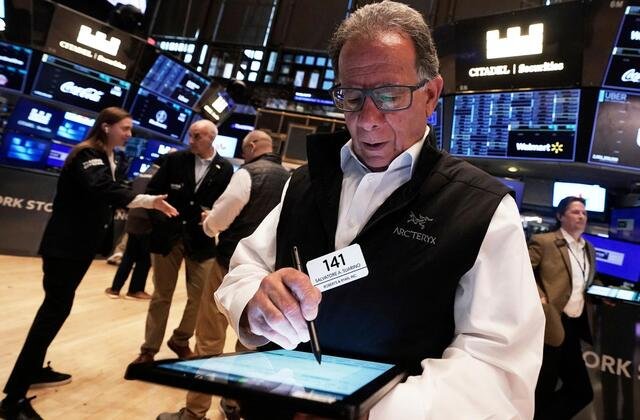The U.S. stocks and dollar tumble has raised alarms across global financial markets, signaling a deeper concern among investors. Over the past few weeks, a steady pullback from American equities and currency has intensified. Investors are seeking safer alternatives amid fears surrounding the U.S. economy, inflation pressures, rising interest rates, and shifting geopolitical dynamics.
In this article, we’ll explore the causes behind the retreat, the current state of markets, how global trends are influencing decisions, and what this could mean for the future of the U.S. economy and financial markets.
Why Are U.S. Investors Pulling Back?
Several interlinked factors have led to the current downturn in the U.S. stock market and the dollar. Let’s break down the key reasons why global investors are moving away from U.S. assets.
1. Inflation and Interest Rate Uncertainty
While inflation has slowed compared to last year’s highs, it still lingers above the Federal Reserve’s 2% target. To combat this, the Fed has taken an aggressive stance, raising interest rates multiple times since 2022. High interest rates make borrowing more expensive and can reduce consumer and business spending.
Many investors fear the Fed may keep rates elevated longer than previously anticipated. This uncertainty has led to decreased confidence in U.S. stocks, especially in sectors like tech, real estate, and consumer goods that are sensitive to rate hikes.
2. Economic Growth Concerns
Despite some positive data, such as strong job numbers and a resilient labor market, many analysts warn that the U.S. economy could slow down significantly by the end of 2025. The signs of a potential “soft landing” are being overshadowed by risks such as reduced consumer spending, high corporate debt, and slowing manufacturing.
When investors sense a slowing economy, they often shift money away from stocks and into more stable investments like bonds or foreign assets.
3. Rising Government Debt and Political Gridlock
Another key concern for investors is the rising national debt, which now exceeds $34 trillion. The recurring battles in Congress over the debt ceiling and budget agreements have added fuel to the fire. Political gridlock creates instability and damages investor confidence in the U.S. government’s ability to manage the economy effectively.
4. Global Diversification and the Rise of Emerging Markets
There’s a growing trend among institutional investors to diversify their portfolios by moving money into other regions—particularly emerging markets. Countries like India, Brazil, and Southeast Asian nations are attracting more capital due to their strong growth prospects, expanding middle classes, and technological development.
This movement weakens the demand for U.S. assets and adds pressure to both the stock market and the U.S. dollar.
How Has the Stock Market Reacted?

The stock market has been on a rollercoaster ride, but the overall trajectory has been downward in recent weeks. Major indices like the S&P 500, Dow Jones Industrial Average, and the Nasdaq have all recorded declines. Here’s a snapshot:
- S&P 500: Down nearly 8% over the past month.
- Nasdaq: Tech-heavy index down approximately 10%.
- Dow Jones: Has fallen 5% amid broader economic fears.
Investors are selling off riskier assets and moving toward defensive stocks or even exiting the market entirely.
Key Sectors Hit Hard
Some sectors have taken a harder hit than others:
- Technology: Higher interest rates make future earnings less attractive.
- Consumer Discretionary: As inflation eats into purchasing power, consumers are spending less.
- Real Estate: Mortgage rates have surged, hurting housing-related stocks.
The U.S. Dollar’s Weakness: What’s Driving It?
While U.S. stocks are feeling the heat, the U.S. dollar is also facing significant challenges. For years, the dollar has been a global safe haven, especially during crises. But now, it’s showing signs of strain.
1. Declining Foreign Investment
Foreign investment into U.S. Treasury bonds and corporate securities has dropped. As international investors pull back, demand for the dollar falls, reducing its value against other currencies.
2. Stronger Global Currencies
Currencies such as the euro, yen, and British pound have all gained strength in recent weeks. In part, this is due to better-than-expected economic performances in those regions and increased confidence in their central banks’ ability to manage inflation and growth.
3. Central Bank Diversification
Global central banks, especially in Asia and the Middle East, are slowly diversifying their reserves away from the U.S. dollar. While the greenback still dominates, its share in global reserves has been declining steadily over the past decade.
Global Impact of the U.S. Stocks and Dollar Tumble
The U.S. stocks and dollar tumble doesn’t only affect American investors. It sends ripples across the global financial system.
1. Emerging Markets at Risk
While some emerging markets have benefitted from diverted capital, others may struggle if the U.S. slowdown leads to reduced demand for exports or tighter financial conditions.
2. Commodity Prices in Flux
Since most global commodities are priced in U.S. dollars, a weaker dollar can lead to higher prices for oil, gold, and agricultural goods. This might help commodity-exporting countries but can increase inflation elsewhere.
3. Shifting Trade Balances
A weaker dollar can help U.S. exports become more competitive globally. However, it can also worsen trade balances for countries heavily reliant on U.S. imports.
Investor Strategies: How Are People Reacting?
In response to the market shifts, investors are adjusting their portfolios and strategies:
1. Moving to Bonds and Gold
With stock market volatility on the rise, many investors are returning to U.S. Treasury bonds and gold as safer options. Bond yields have risen, making them more attractive than high-risk equities.
2. Investing in International Stocks
Some investors are redirecting funds into international stock markets that show better growth potential. European and Asian markets have outperformed the U.S. in some cases due to better inflation control and stronger GDP growth.
3. Holding More Cash
Cash is becoming king again. Investors are holding more cash or investing in money market funds, which offer better returns now due to higher interest rates.

What Does This Mean for the Average American?
The average American might not track the S&P 500 daily, but the U.S. stocks and dollar tumble affects everyday life in subtle and not-so-subtle ways.
1. Retirement Accounts
If you have a 401(k) or IRA, chances are it’s tied to the stock market. The recent downturn may affect your portfolio’s value and long-term savings plans.
2. Travel and Imports
A weaker dollar means foreign travel gets more expensive. Additionally, imported goods—from electronics to luxury brands—might cost more due to exchange rate fluctuations.
3. Inflation and Interest Rates
If the Fed continues to raise rates in response to inflation and the weakening dollar, loans, mortgages, and credit card payments could become more expensive.
What’s Next? Predictions and Outlook
The future remains uncertain. Will this retreat continue or stabilize? Here are a few possibilities:
- Soft Landing: If inflation continues to cool and the Fed pauses rate hikes, confidence may return slowly.
- Global Rebalancing: Continued investor interest in foreign markets may lead to a more balanced global financial landscape.
- Volatility Ahead: With elections, global conflicts, and unpredictable data, volatility is likely to remain high in the near term.
Financial analysts suggest remaining cautious while also seeking diversification to weather potential storms.
Final Thoughts
The recent U.S. stocks and dollar tumble is a signal that investors are rethinking their faith in the American market. Driven by economic concerns, inflation, global shifts, and policy uncertainty, both domestic and foreign players are taking a step back.
While this doesn’t necessarily mean a full-blown crisis is on the horizon, it does highlight the need for smarter investing, economic clarity, and stable governance. As the world economy continues to evolve, the U.S. must adapt to remain a key player.
Read Next – DHL Shipment Suspension Over $800 Shocks Global Buyers






